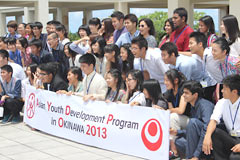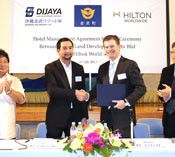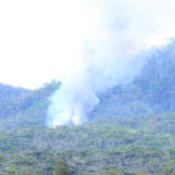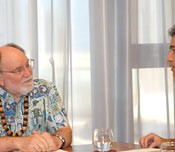Top News

August 6, 2013 Ryukyu Shimpo
The opening ceremony for the Asian Youth Development Program hosted by the Okinawa Prefectural Government was held on August 5 at the Bankoku Shinryokan in Nago. A total of 54 high school students from 13 South East Asian countries and Japan, including Okinawa, took part in the ceremony. During the program, which is designed for the students to learn about energy issues, they attend lectures from specialists such as university professors and visit companies. Each group will report on their business plans to resolve energy issues at the Okinawa Convention Center, on 20 August, which is the last day of the program.
In her welcome speech, Kurara Chinen, a 16-year-old from Naha International High School said, “We want to think together, enjoy ourselves, and to forge strong bonds.” As a representative for the overseas participants Cathlene Rose Umali Monfero, 15-year-old fourth-generation Okinawan from the Philippines Okinawa Kenjinkai said, “I would like to expand my knowledge and experience many things. When I go back to my country, I want to pass those things on to many people. Our connections here will lead to a better environment in Asian countries.”
The Okinawa Prefectural Government is aiming to create “The Island of Interaction and Coexistence,” as part of the Okinawa 21st Century Vision to resolve environmental issues through cross-border exchange among young people.
(English translation by T&CT, Hitomi Shinzato and Mark Ealey)
Go to Japanese

August 9, 2013 Ryukyu Shimpo
In the morning of August 8, a charter flight organized by Jumbo Tours in Naha brought 288 people from Bangkok to Naha. That same day, 282 people departed from Okinawa for Thailand. This is the second charter flight between Naha and Bangkok in 2013.
The Thai tourists will stay for five days in Okinawa, during which they will visit Okinawa World in Nanjo and go sightseeing and shopping.
Jumbo Tours is planning to operate four charter flights between Okinawa and Thailand. They will run the other two flights in October and December.
(English translation by T&CT, Lima Tokumori and Mark Ealey)
Go to Japanese
August 9, 2013 Ryukyu Shimpo
JX Nippon Oil & Energy Corporation plans to build a 12 megawatts solar power plant in Uruma. Involving a total investment of about 3.5 billion yen, it aims to start operating the plant in March 2015. The company is making use of the land in Uruma owned by the Okinawa CTS Corporation, one of the group of companies. It will be the largest solar power plant in Okinawa.
JX Nippon’s solar power plant will comprise six facilities, including two plants already running. The plant in Okinawa will be the largest that the company owns.
According to a plan released on August 8, it will use about 180,000 square meters of vacant ground, which the Okinawa CTS has reserved for future oil storage. The company expects to generate the equivalent of the annual power needs of about 2,700 households (the average household uses about 5,500 kWh of electricity). JX Nippon will sell all of the power produced at the plant to the Okinawa Electric Power Co.
A spokesman for the company explained, “We will not increase the oil storage capacity. To take advantage of these assets we’ve decided to have a go at the power-generation business.” After the plant is built, JX Nippon will entrust its maintenance to the Okinawa CTS.
The company is working on solar power generation projects to take advantage of unused land owned by the group companies. The system for purchase of renewable energy sourced electricity by electric utilities that came into effect in July 2012 encouraged the company to move on the new business. JX Energy already has mega solar plants in Yamaguchi and Miyagi prefectures. The Miyagi facility has an output capacity of 1 megawatt and the Yamaguchi facility 1.75 megawatts. Both of these facilities are already generating power and the Ibaraki facility, with a capacity of 2 megawatts, will begin to generate in November. The company is building mega solar power plants in Fukushima and Akita some time after 2014.
The total solar power output of the six facilities, including those planned for construction, will be about 22 megawatts.
(English translation by T&CT, Mark Ealey)
Go to Japanese

August 11, 2013 Ryukyu Shimpo
In the afternoon of August 10, a Ryukyu Shimpo photographer took a picture of the spot in the Central Training Area, Ginoza, where a Kadena-based HH-60 helicopter crashed on August 5. The slope of the forest near the landing strip was exposed in the fire caused by the crash. From his helicopter the photographer could also see the area where the trees had been burnt to a reddish brown near the Okawa Dam, a source of drinking water for local residents.
(English translation by T&CT, Mark Ealey)
Go to Japanese

An area of forest was laid bare by a blaze caused by the HH-60 helicopter crash. The Okawa Dam is at the lower-right corner of the slope, in the Central Training Area, near Camp Hansen, Ginoza. (Photograph taken by Futoshi Hanashiro, at 2:40 p.m. on August 10.)

July 30, 2013 Ryukyu Shimpo
Kin Town announced on July 30 that Hilton Worldwide, an American global hospitality company, will manage a large resort hotel at a site on the former U.S. military Gimbaru Training Area, which the U.S. military returned to Kin Town and other owners in July 2011. Kin Town Mayor Tsuyoshi Gibu made the announcement at the Central Community Center.
Hilton and Malaysian property developer Dijaya Corporation Berhad held a ceremony in which they entered into a contract and the local government and Dijaya reached an agreement on the use of the site.
The name of the new hotel will be Hilton Okinawa Kin. It will have nine floors above ground and 190 guestrooms.
Hilton aims to start building in 2014 and to open in 2016. It will be the twelfth hotel that Hilton operates in Japan. Hilton already owns hotels in Naha and Chatan. The hotel in Chatan opens in 2014.
At the ceremony, Guy Phillips, Hilton Worldwide vice president of development, Asia Pacific, said that he wants the hotel to be important to the town and contribute to tourism industry in the area and Okinawa. Mayor Gibu wants Kin Town to move away from being a base-dependent economy. He said, “I want the Hilton resort hotel to stimulate the economy on the east coast of Okinawa.”
Hilton will build the hotel on one of the five areas available for use on the site of what used to be the Gimbaru Training Area.
Wanting to make the hotel prestigious by using the Hilton brand, Dijaya increased the budget for the project from 60 billion yen, the cost originally planned, to 80 billion yen.
The town plans to build long-stay housing, condominium apartments and a large commercial complex containing stores selling local products in the second to fourth areas of the site. Dijaya will manage these buildings. The town has not yet decided who will manage the hotel to be built on the fifth area.
(English translation by T&CT, Mark Ealey)
Go to Japanese

July 28, 2013 Nana Sasahara, correspondent of Ryukyu Shimpo
The 95th Tonaki Water Sports Day for Children was held recently at the Higashi no hama on Tonaki Island. Many children and residents, including 30 children and pupils from Tonaki School (kindergarten, elementary and junior high school) and people from both on and out of the island, took part in the event. This is an annual event, which has been held since 1919 on this island surrounded by the beautiful sea.
Games were held under a blue, clear and sunny sky. Junior high school pupils competed in swimming races and relay games, with all of the children showing the benefits of their practice in swimming classes.

A police officer on Tonaki Island starts the annual water sports festival.
White and red teams competed in games, including piggy-back fights,
tamaire game (a game in which children throw balls into a basket and compete by counting the number of balls that went in), a treasure hunt and a dragon boat race. Everyone enjoyed a tug-of-war in the water.
(English translation by T&CT, Hitomi Shinzato and Mark Ealey)
Go to Japanese

August 6, 2013 Ryukyu Shimpo
At 4:00 p.m. on August 5, a Kadena-based HH-60 Pave Hawk helicopter crashed in flames in the Central Training Area near Camp Hansen in Matsuda, Ginoza. According to the Ministry of Defense and the U.S. military, there were at least four people on board. The three who were rescued are in a stable condition in hospital, but one was found dead. The grass, woods and helicopter wreckage at the crash site were still burning at 9:00 p.m. Other U.S. military helicopters attended to the fire. According to the police, damage to other people and the spread of debris have not been confirmed in the civilian areas outside the training area.
Shortly after the crash, Ginoza municipal officials, Ishikawa Police, and the Kin District Fire Station asked the U.S. military for access to the scene, but were refused. Some people worked in their houses and in fields just two kilometers away. There is a golf course within two kilometers, the village office is about 3.8 kilometers away and the Okinawa Expressway just one kilometer from the scene of the crash.
(English translation by T&CT, Mark Ealey)
Go to Japanese
Okinawa Governor asks central government to prevent recurrence of incidents
August 7, 2013 Ryukyu Shimpo
Okinawa Governor Hirokazu Nakaima met Chief Cabinet Secretary Yoshihide Suga and Defense Minister Itsunori Onodera in Tokyo on August 6 to discuss the U.S. military helicopter crash. The governor asked the ministers to strongly urge the U.S. military to ground HH-60 helicopters while the cause of the crash is being examined and measures are being drawn up to prevent a recurrence. Government officials revealed that they had asked the U.S. to take the measures referred to by the governor.
Go to Japanese
Ginoza Village assembly adopts protest resolution against U.S. helicopter crash
August 7, 2013 Ryukyu Shimpo
On August 6 the Ginoza Village Assembly unanimously adopted a resolution of protest against the U.S. helicopter crash. Representatives of the Okinawa Prefectural Government and Ginoza Village Office protested to the Okinawa Defense Bureau. Many municipal assemblies, such as the Okinawa Prefectural Assembly, Kadena and Kin, also moved to adopt protest resolutions. Citizens groups held protest rallies in front of both the Kadena Air Base and Futenma Air Station about the crash and further MV-22 Osprey coming.
Go to Japanese
U.S. military imposes no-fly zone over crash site
August 8, 2013 Ryukyu Shimpo
From August 6, Kadena Air Base officials imposed no-fly zone over the site where the HH-60 helicopter crashed near Camp Hansen in Ginoza. Having issued a NOTAM (notice to airmen), the military restricted civilian aircraft, including news helicopters’ access to airspace above the scene. The Ministry of Land, Infrastructure, Transport, and Tourism stated that it did not receive prior notice from the U.S. military. An official of the ministry commented that the NOTAM was invalid because it was not based on aviation law. The U.S. military will impose this no-fly zone until August 15. On August 6, the military authorities blocked all civilian aircraft from flying within an 11 km radius and up to 3 kms above the crash site. News helicopters were not able to get close to the scene that day.
Go to Japanese

July 23, 2013 Ryukyu Shimpo
In a meeting of the Japan-U.S. Joint Committee on July 22, the Japanese and U.S. governments approved setting up fences at Gate 3 of U.S. Marine Corps Air Station Futenma in Nodake, Ginowan. To oppose the deployment last September of the first squadron of Osprey to Okinawa citizens staged a sit-in protest at the gate, preventing access from the base to and from Ginowan City. The U.S. responded by asking the Japanese government to build fences around the gate and the Ministry of Defense began work on this at around 8:00 p.m. on 22 July. Citizens who were protesting scuffled with the workers, creating a tense atmosphere. Groups opposing the deployment of the aircraft are also critical of the construction. The ministry will erect about 20 meters of fencing along the pavement beside Route 330 which is next to the gate, thereby reducing the space available between existing fences and the road.

Where the fences are to be erected (red).
(English translation by T&CT, Lima Tokumori and Mark Ealey)
The Japanese government will pay about two million yen to cover the cost of construction, facility management and surveying. The ministry states that the Japanese government is obliged to do this because it provides the land for the bases. A sole-source contractor will take one week to erect the fences.
The ministry stated, “The U.S. government has asked the Japanese government to erect fences to ensure access because of problems entering and leaving through the gate.” They went on to say, “The Japanese government has examined the issue and agreed with the U.S. assessment.” The central government has started construction because citizens’ movements concern them and they are trying to avoid s additional Osprey coming to Okinawa in early August having an influence on the House of Councilors elections.
Susumu Matayoshi, the head of the Executive Office of the Governor, said, “We would like to confirm what exactly occurred including any trouble.”
Go to Japanese

Go To Video

August 1, 2013 Ryukyu Shimpo
On a visit to Hawaii, Susumu Matayoshi, the head of the Executive Office of the Governor, met State of Hawaii Governor Neil Abercrombie at the Government Offices in the afternoon on July 30. Abercrombie stated that he is willing to accept U.S. Marines currently stationed in Okinawa.
The U.S. and Japanese governments have agreed on a plan to transfer 2,700 Marines from Okinawa to Hawaii. Abercrombie suggested the governments move ahead with the plan as soon as possible, adding that the Hawaii State government is ready to accept the troops and has a clear idea of the infrastructure requirements. Later that day, Matayoshi talked about his meeting with Abercrombie in a video-link press conference held at the Okinawa Prefectural Government Office.
The prefectural and state governments confirmed that they will move to exchange opinions and information with one another on base issues in Okinawa, including transfer of the Marines.
Abercrombie has previously mentioned also accepting the family members of Marines personnel, but he did not do so on this occasion. He said the U.S. and Japanese governments have not make sufficient effort to resolve the issue of U.S. military bases being concentrated on Okinawa.
The U.S. military plans to transfer 2,700 Marines from Okinawa to Hawaii. This is in keeping with the U.S. and Japanese governments adjusting the plans to realign U.S. forces in Japan last April, something that the Commander Of United States Pacific Command has referred to in statements in Congress.
(English translation by T&CT, Mark Ealey)
Go to Japanese

July 26, 2013 Ryukyu Shimpo
The Shioya Soybeans Club, which is working to restore indigenous Okinawan soybeans such as oohigu and takaanda, held a meeting at the Shioya Community Hall on July 24. The club reported that crop yields reached a record high of six kilograms this season. They will replant beans in October and further increase their stock of seeds. They plan to cook gojiru, which is made of crushed beans with soup stock or miso, and serve it to users of day services.
In Shioya, people had a history of cultivating soybeans in terraced fields in the bay until 1960. However, the import of foreign soybeans and the migration of people to urban areas led to a fall in production and the seeds died out.
In December 2009, nine residents of the district formed a group to use deserted arable land and restore indigenous seeds. They received about 500 grams of seeds from the Naha City Hantagawa Residents’ Association, which had long been working to restore indigenous seeds. Each of the members have been growing seeds and trying to increase their number. They plant twice, in February and October. Damage from typhoons and insects prevented seeds from bearing fruit, so the harvested beans have not yet been enough to eat.
Mitsunori Miyagi, 84, the president of the club, said, “We’ve got enough seeds this time. The challenge is to spread the use of soybeans and get younger people attracted to them.”
The next planting is in October. If there is a good harvest, they plan to make tofu out of the garden-fresh soybeans.
(English translation by T&CT, Megumi Chibana and Mark Ealey)
Go to Japanese
August 4, 2013 Ryukyu Shimpo
Two MV-22 Osprey aircraft arrived on August 3 at U.S. Marine Corps Air Station Futenma from Iwakuni in Yamaguchi. They are the first of an additional 12 tilt-rotor aircraft, which take off and land like a helicopter. One person was arrested in front of the base’s Nodake Gate in clashes between the police and residents opposed to the Osprey. This is the first such arrest in the sit-in protests. Anger towards the U.S. military is growing because military officials went ahead with the deployment of the Osprey despite opposition from residents.
In an “unexpected response,” while U.S. Marine officials opened the aircraft to the media, they did not reply to key questions. Locals’ concerns over the risk of crashes or noise from aircraft have not been addressed, so residents’ fears have increased.
At 8:30 a.m. on August 3, about 60 people succeeded in temporarily blocking the entrance to the base by holding a sit-in in front of the gate. The police forcibly cleared the way to allow traffic to flow, lifting up and removing passively resisting protesters. During the struggle between the police and citizens, one protester was arrested for interfering with a police officer in the line of duty. Confusion reigned for several minutes as residents objected, shouting, “Unfair arrest!” and “Let him go!”
Setsuko Ohama, 67, voiced her anger towards the police use of force, saying, “We have opted for the minimum level of resistance available to us now. Why do they stop us?”
With occasional breaks, the protest rally continued under the hot sun.
When an Osprey aircraft suddenly appeared in the sky and roared through the Nodake area at about 4:30 p.m. residents shouted, “Go home Osprey,” “We will not allow more Ospreys.” More than 200 people took part in the rally, chanting and raising their fists against the Osprey.
(English translation by T&CT, Mark Ealey)
Go to Japanese

Go To Video














 Webcam(Kokusai Street)
Webcam(Kokusai Street)


